Irrational Numbers
We know that a number which cannot be written in the form of , where p and q are integers and q ≠ 0, is known as an irrational number.
where p and q are integers and q ≠ 0, is known as an irrational number.
For example: all numbers of the form , where p is a prime number such as etc.,
where p is a prime number such as etc.,  are irrational numbers.
are irrational numbers.
How can we prove that these are irrational numbers?
We can prove this by making use of a theorem which can be stated as follows.
“If p divides a2, then p divides a (where p is a prime number and a is a positive integer)”.
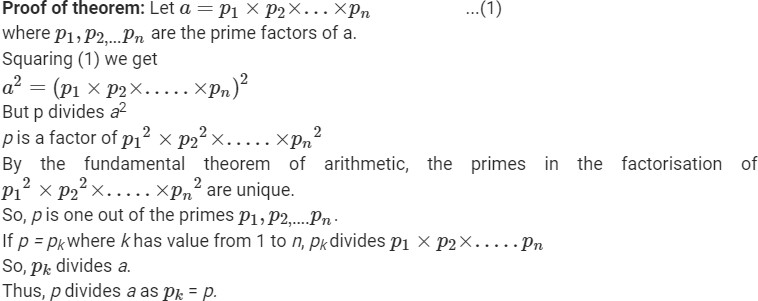
So go through the given video to understand the application of the above stated property.
Similarly, we can prove that square roots of other prime numbers like , etc. are irrational numbers.
etc. are irrational numbers.
Besides these irrational numbers, there are some other irrational numbers like etc.
We can also prove why these numbers are irrational. Before this, let us first see what happens to irrational numbers, when we apply certain mathematical operations on them.
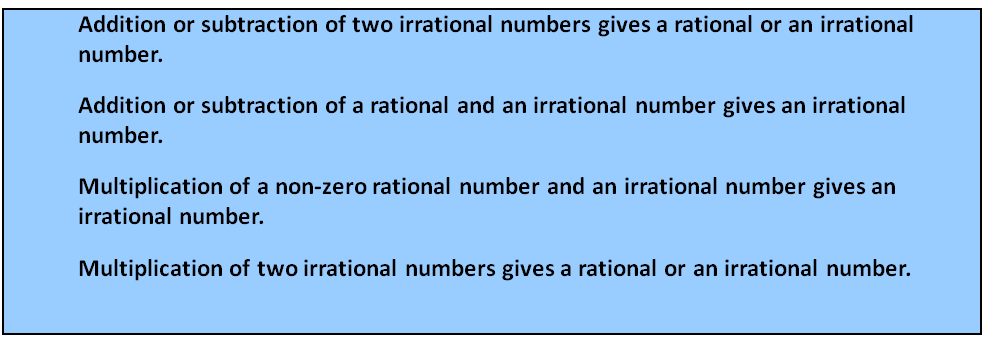
We will now prove that  is irrational.
is irrational.
We know that  is irrational (as proved before).
is irrational (as proved before).
Now, the multiplication of a rational and an irrational number gives an irrational number. Therefore,  is an irrational number.
is an irrational number.
Let us now try to understand the concept further through some more examples.
Example 1: Prove that  is irrational. Solution:
is irrational. Solution:
Let us assume that is not irrational, i.e.
is not irrational, i.e. is a rational number.
is a rational number.
Then we can write , where a and b are integers andb ≠ 0.
where a and b are integers andb ≠ 0.
Let a and b have a common factor other than 1.
After dividing by the common factor, we obtain
 , where c and d are co-prime numbers.
, where c and d are co-prime numbers.



As c, d and 2 are integers,  and
and  are rational numbers.
are rational numbers.
Thus, is rational.
is rational.
![]() is rational as the difference of two rational numbers is again a rational number.
is rational as the difference of two rational numbers is again a rational number.
This is a contradiction as is irrational.
is irrational.
Therefore, our assumption that  is rational is wrong.
is rational is wrong.
Hence,  is irrational.
is irrational.
Example 2: Prove that  is irrational.
is irrational.
Solution:
Let us assume  is rational. Then, we can write
is rational. Then, we can write
 ,
,
where a and b are co-prime and b ≠ 0.
⇒![]()
Now, as a and b are integers, is rational or
is rational or  is a rational number.
is a rational number.
This means that is rational.
is rational.
This is a contradiction as is irrational.
is irrational.
Therefore, our assumption that  is rational is wrong.
is rational is wrong.
Hence,  is an irrational number.
is an irrational number.
Decimal Expansions of Rational Numbers
The Need for Converting Rational Numbers into Decimals
A carpenter wishes to make a point on the edge of a wooden plank at 95 mm from any end. He has a centimeter tape, but how can he use that to mark the required point?

Simple! He should convert 95 mm into its corresponding centimeter value, i.e., 9.5 cm and then measure and mark the required length on the wooden plank.
This is just one of the many situations in life when we face the need to convert numbers into decimals. In this lesson, we will learn to convert rational numbers into decimals, observe the types of decimal numbers, and solve a few examples based on this concept.
Know More
Two rational numbers  and
and are equal if and only if ad = bc.
are equal if and only if ad = bc.
Take, for example, the rational numbers  and
and  . Let us see if they are equal or not. Here, a = 2, b = 4, c = 3 and d = 6
. Let us see if they are equal or not. Here, a = 2, b = 4, c = 3 and d = 6
Now, we have:
ad = 2 × 6 = 12
bc = 4 × 3 = 12
Since ad = bc, we obtain = .
= .
We know that the form represents the division of integer p by the integer q. By solving
represents the division of integer p by the integer q. By solving
this division, we can find the decimal equivalent of the rational number  . Now, let us convert the numbers
. Now, let us convert the numbers ,
,  and
and into decimals using the long division method.
into decimals using the long division method.
![]()
![]()

While the remainder is zero in the division of 5 by 8, it is not so in case of the other two divisions. Thus, we can get two different cases in the decimal expansions of rational numbers.
Observing the Decimal Expansions of Rational Numbers
We can get the following two cases in the decimal expansions of rational numbers.
Case I: When the remainder is zero
In this case, the remainder becomes zero and the quotient or decimal expansion terminates after a finite number of digits after the decimal point. For example, in the decimal
expansion of ,  we get the remainder as zero and the quotient as 0.625.
we get the remainder as zero and the quotient as 0.625.
Case II: When the remainder is never zero
In this case, the remainder never becomes zero and the corresponding decimal expansion
is non-terminating. For example, in the decimal expansions of and
and , we see that the remainder never becomes zero and their corresponding quotients are non-terminating decimals.
, we see that the remainder never becomes zero and their corresponding quotients are non-terminating decimals.
When we divide 4 by 3 and 2 by 7, we get 1.3333… and 0.285714285714… as the respective quotients. In these decimal numbers, the digit ‘3’ and the group of digits
‘285714’ get repeated. Therefore, we can write and
and
Here, the symbol  indicates the digit or group of digits
indicates the digit or group of digits
that gets repeated.
Solved Examples
Example 1: Write the decimal expansion of  and find if it is terminating or non- terminating and repeating.
and find if it is terminating or non- terminating and repeating.
Solution:
Here is the long division method to find the decimal expansion of .

Hence, the decimal expansion of is 49.48. Since the remainder is obtained as zero, the decimal numberis terminating.
is 49.48. Since the remainder is obtained as zero, the decimal numberis terminating.
Example 2: Write the decimal expansion of  and find if it is terminating or non- terminating and repeating.
and find if it is terminating or non- terminating and repeating.
Solution:
Here is the long division method to find the decimal expansion of .

Hence, the decimal expansion of is 87.33 Since the remainder 9 is obtained again
is 87.33 Since the remainder 9 is obtained again
and again, the decimal numberis non-terminating and repeating. The decimal number can also be written as .![]()
Medium
Example 1: Find the decimal expansion of each of the following rational numbers and write the nature of the same.
1.
2.
3.
4.
Solution:
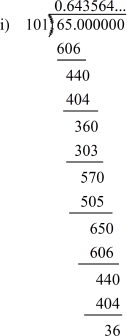
We have  = 0.64356435... =
= 0.64356435... =
The group of digits ‘6435’ repeats after the decimal point. Hence, the decimal expansion of the given rational number is non-terminating and repeating.
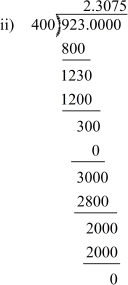
We have = 2.3075
= 2.3075
Hence, the given rational number has a terminating decimal expansion.
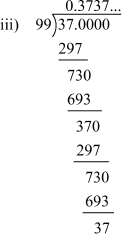
We have = 0.3737... =
= 0.3737... =
The pair of digits ‘37’ repeats after the decimal point. Hence, the decimal expansion of the given rational number is non-terminating and repeating.
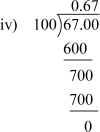
We have![]() = 0.67
= 0.67
Hence, the given rational number has a terminating decimal expansion.
Terminating and Non-terminating Repeating Decimal Expansions of Rational Numbers
We can find the decimal expansion of rational numbers using long division method.
However, it is possible to check whether the decimal expansion is terminating or non- terminating without actually carrying out long division also.
Let us start by taking a few rational numbers in the decimal form.
(a)

(b)
0.275
On prime factorizing the numerator and the denominator, we obtain

Can you see a pattern in the two examples?
We notice that the given examples are rational numbers with terminating decimal expansions. When they are written in the  form, where p and q are co-prime
form, where p and q are co-prime
(the HCF of p and q is 1), the denominator, when written in the form of prime factors, has 2 or 5 or both.
The above observation brings us to the given theorem.
If x is a rational number with terminating decimal expansion, then it can be expressedin the  form, where p and q are co-prime (the HCF of p and q is 1) and the prime factorisation of q is of the form 2n5m, where n and m are non-negative integers.
form, where p and q are co-prime (the HCF of p and q is 1) and the prime factorisation of q is of the form 2n5m, where n and m are non-negative integers.
Contrary to this, if the prime factorisation of q is not of the form 2n5m, where n and m are non-negative integers, then the decimal expansion is a
non-terminating one.
Let us see a few examples that will help verify this theorem.
(a)
(b)
(c) 
(d) 
Note that in examples (b) and (d), each of the denominators is composed only of the prime factors 2 and 5, because of which, the decimal expansion is terminating. However, in examples (a) and (c), each of the denominators has at least one prime factor other than 2 and 5 in their prime factorisation, because of which, the decimal expansion is non- terminating and repetitive.
To summarize the above results, we can say that:

Let us solve a few examples to understand this concept better.
Example 1: Without carrying out the actual division, find if the following rational numbers have a terminating or a non-terminating decimal expansion.
(a)
(b) 
Solution:
(a)
As the denominator can be written in the form 2n5m, where n = 6 and m = 2 are non-negative integers, the given rational number has a terminating decimal expansion.
(b)
As denominator cannot be written in the form 2n5m, where n and m are non-negative integers, the given rational number has a non-terminating decimal expansion.
Example 2: Without carrying out the actual division, find if the expression  has a terminating or a non-terminating decimal expansion.
has a terminating or a non-terminating decimal expansion.
Solution: =
=
As the denominator can be written in the form 2n5m, where n = 7and m = 0 are non-negative integers, the given rational number has a terminating decimal expansion.


Hence, 5.5859375 is the decimal expansion of the given rational number.

 Carrier Point
Carrier Point
 ACERISE INDIA
ACERISE INDIA
